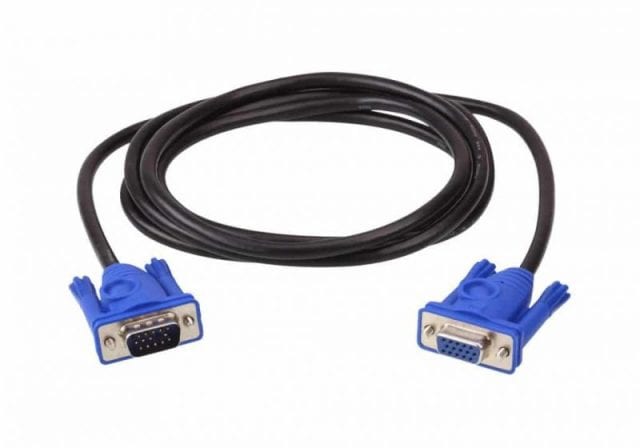A VGA cable is a type of cable used by computer systems that often carry visual display from the CPU to the monitor. It is made up of a cable and a connector at each end.
VGA stands for visual graphics array or visual graphics adapter. It was designed by IBM and introduced in 1987.
Features of a VGA
* It produces a 640×480 color screen display resolution.
* It refreshes at a rate of 60GHZ.
*. It displays 16 colors at a time.
What Is a VGA Cable Used for?

1. Connects a computer with its parts- A VGA cable is a good cable for connectivity. It connects the computer with the monitor. You can also use it to connect your laptop to a monitor if your screen is bad and you need to take care of some things before you get it changed or fixed.
2. Transfers picture signals- A VGA cable is used to transfer picture signals from the computer to the monitor.
3. It displays pictures and videos- A VGA cable is very useful when it comes to displaying pictures and videos. This is because as the picture or video signals is being transferred, it displays them on the monitor.
4. VGA cable supports high resolution- A VGA cable normally displays pictures and videos in 16 colors at a time, while providing a screen resolution of 640×480.
5. Converts hidden diagrams- A VGA cable automatically generated a code that convert diagrams that are blocked. It pushes those blocked diagrams directly to the computer hardware.
Advantages of using a VGA cable
- It is not complicated to use. As earlier mentioned, VGA cables normally transfer analog signals. However, if the gear and cabling are both in perfect conditions, the signal will work smoothly. So, this means that it is very easy to use as compared to other computer cables.
- Signals are easily split. VGA cables can be split with other simple distribution amplifiers easily without any complication.
- Secured connection. VGA cable is made up of thumb-like screws which if screwed tightly ensures a secured connection without any fear that it will ever slip out.
- One VGA standard. The VGA standard means that as long as the equipment or device has VGA-out, it will always connect perfectly to a VGA-in simply.
- It gives all the 5 primary colors (RGBHV). A VGA cable can be fragmented into a 5-wire component signals that can display all the 5 primary colors (RGBHV) and it can be used with other high level equipment and devices.
- Signal range can be extended. A VGA cable signal range can be extended by using an amplifier. Although, it produces varying outcomes depending on the level of extension. This means that can run easily up to 150 before the signal begins to degrade.
- It can serve universally. The cable can serve as a universal analog cable that can be capable of transmitting and transferring the 5 primary colors (RGBHV), Composite, YPbPr and even s-video signals.
Disadvantages
- Old and outdated technology when you compare it to a DVI or HDMI. VGA cable is an older and outdated cable technology. This has limited its usage because it supports lesser amounts of resolution.
- For you to have longer runs, you must have a higher gauge VGA cable.
- VGA cable has 15 pins on its head and only 14 are technically used. It is very easy to bend one unused pin which can corrupt and affect the overall output of an image or video.
How to Identify a VGA cable
You can identify a VGA cable by merely looking at the inside of the plug head. Most VGA cables are designed with fourteen pins on the inside and a hole showing the fifteenth. Depending on your system’s make up, it could come with other pins missing on the inside.
VGA pin functions
Pin 1: takes care or displays the red color for video or image.
Pin 2: displays the green color for image and video.
Pin 3: displays the blue color for image and video.
Pin 4: it is for monitor ID2.
Pin 5: it is for TTL Ground ie self-test monitor.
Pin 6: it displays for red analog ground.
Pin 7: it displays for green analog ground.
Pin 8: displays for blue analog ground.
Pin 9: serves as keyhole for plugging
Pin 10: it syncs ground
Pin 11: it is for monitor ID0.
Pin 12: It is for monitor ID1.
Pin 13: it syncs horizontally.
Pin 14: it syncs vertically.
Pin 15: it is for monitor ID3.
What should you go for- VGA, DVI, or HDMI?
Now, when the question becomes what you should go with between VGA, DVI, and HDMI, it will all depend on what you have. Even with that, there are some monitors that come with ports for all three cables.
HDMI
Standing for High-Definition Multimedia Interface, HDMI is not the first that you will think of using unless what you want is a watch Blu-ray movies- for a PC that comes with a Blu-ray drive. Also, if you want to connect a PC to an HDTV, this is the best for you.
See Also: 7 Best Projectors Under $200- Excellent Performance (Review)
VGA
The thing with these cables is that because they are the most popular, they are also much cheaper since they are mass produced. As pointed out already, they are outdated, even as they are still widely used.
DVI
At the end of the day, the best of them all is the DVI which instead of the analogue signal that you get with VGA, it offers you digital signal. More so, it supports the HDCP protocol which you need to view that kind of protected video content. The best part is that the cable is not expensive.














